Thurn und Taxis
Preparazione del gioco
Digitando il comando /join nella chat è possibile aggiungere da 2 a 4 giocatori. Digitando invece /start si da inizio alla partita. Eventualmente in alternativa si può anche usare lo Strumento di Gioco..
Il gioco
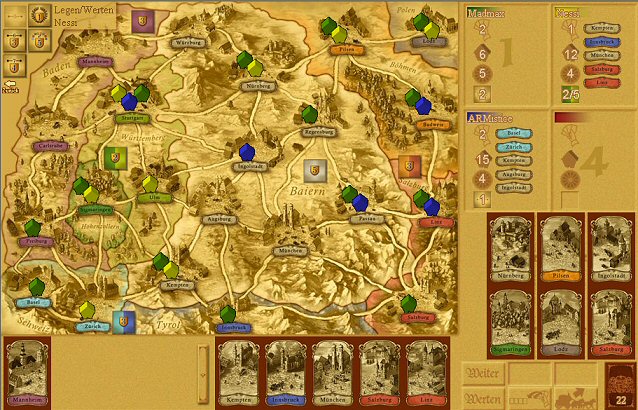
The players' task is to set up an effective stagecoach operation. Each player tries to place as many of their 20 route posts as possible in the 22 cities by skillfully building routes. Players compete for the most valuable bonus tiles, which can be obtained for fully occupied areas and long routes. In addition, everyone tries to acquire larger carriages for their postal service during the course of the game.
Tavolo di gioco
The game board shows southern Germany with the neighboring countries. There are a total of 22 cities on the map, which are connected by roads. Below this, on the left-hand side, you will find your own hand cards and, to the right of the movable separator bar, the played route cards.
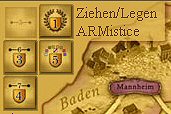
The bonus tiles on display are shown at the top left, with the status display to the right showing which player is currently taking which action.
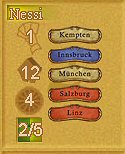
To the right of the map you can see the player display for all players. It shows from top to bottom:
- Number of cards in hand
- Number of track posts not yet laid out
- Size of the carriage (displayed in detail via tooltip)
- Number of bonus tiles and the type of the last bonus tile acquired. In your own display, this is divided into two parts and shows the number/point value of your own bonus tiles. If you move the mouse over your own bonus display, you will see a detailed display of your own bonus tiles to the left of the card display.
- you must draw a card
- you must lay out a card
- You can score the track on display if it has a length of at least 3
- You can perform another action by supporting an official
- Place a route guard in one city per country involved in the route
- You place a marshal in one country in every town on the route.
- They are only available in limited quantities. The rule here is: first come, first served
- They are sorted so that the highest is at the top and the lowest at the bottom
- Points of the highest carriage card: Carriages of size 3/4/5/6/7 count 2/3/5/7/10 victory points
- Points from all bonus tiles received
- According to the number of marshals not used
- In order to obtain the bonus tile for Prussia, you must build a house in all seven cities in both parts of Prussia
- The free imperial cities of Frankfurt, Hamburg, Bremen and Lübeck do not belong to any country. A maximum of one imperial city may be scored per scoring. The player who scores an imperial city first receives the bonus tile displayed there. In order to receive the "All countries" bonus tile, you must be represented at least once in each country. Imperial cities do not count.
- the official "Wagner" and the carriage cards from the basic game are not required
- each player receives a carriage card with two horses
The current route is displayed next to it.
Below the player display are the six face-up city cards in the card display, below them the display for the officials and to the right of them the face-down draw pile.
Svolgimento
Each turn consists of 2-3 actions:
Officials
You can use exactly one of the four officials to your advantage per turn. They have the following properties:

Officer - exchanges the display of the six face-up cards
The bailiff can only be chosen if you have at least one card in your hand. If you don't like any of the cards in your hand, instead of drawing a face-down card at random, you can use the bailiff to swap the entire card display and hope for a better selection. To do this, simply click on the bailiff button.

Postmaster - allows you to draw a second card
You can draw two city cards at the start instead of just one. The postmaster does not have to be selected explicitly; you simply draw a second card after the first. If you don't have a card in your hand at the start of a round, you must choose the postmaster (i.e. also at the start of the game!).

Postillion - allows you to play a second card
The Postillion allows you to add a second card to your route. The same requirements apply as for the first map. The Postillion does not have to be activated separately either; you simply click on a second card to lay it out.

Wagner - extends the route by two virtual cards when purchasing a carriage
The Wagner helps you to get a larger carriage than you would get from the route you have played. For example, if you have a route of length 4 and already have a carriage of five, you can get a carriage of six with the Wagner (see "Scoring" for requirements). However, the virtual extension only applies to the carriage card and does not count towards the "route length" bonus tile. If you want to use the Wagner, you must select the Wagner button.
Draw card(s)
At the start of the round, the active player must draw a city card. He may choose this from one of the six face-up cards in the display or draw a card from the face-down pile. The display is replenished immediately.
Play card(s)
The active player must play a card. If they do not have any cards on display, they may play any card. If he already has a route on display, the card he now plays must connect to this route, i.e. the city must have a direct road connection to one of the two outer cities of the route on display. This means that no branches may be formed and the route may not be split. In addition, the city must not yet be represented in the route.
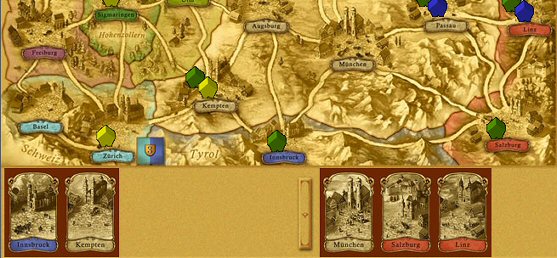
The route Munich - Salzburg - Linz has so far been laid out on the right. The player still has Innsbruck and Kempten in his hand. Kempten may not be played (immediately) because it has no direct road connection to either Linz or Munich. However, Innsbruck may be played because it has a direct connection to Munich.
If the player selects the Innsbruck card, the possible selection windows appear to the right of the route on display; in this case, only one appears because Innsbruck can only be connected to Munich, but not to Linz. Click to create the map there. Kempten should now also be laid out (with the help of the postillion), as this could now be laid out at Innsbruck.
If the unfavorable case arises that a player cannot connect any of their hand cards to the route on display, they must tear it down and start a new one.

Here in the picture is the route Carlsruhe - Mannheim - Würzburg, to which neither Linz nor Salzburg can be connected in accordance with the rules. With a heavy heart, the player must now tear down his route (click on the tear-off button on the right), which will of course not be scored, and must then start a new one with Linz or Salzburg.
Route evaluation
If you have reached a route length of at least 3 in your turn, you can now score this route. If you don't want to do this, end your turn by clicking on the Continue button.
If you decide to score, you can now place route markers in the cities on your route. There are two ways to do this:
or
All laid out cities are marked with a route marker in the player's brightest color. Now select the cities that you don't want to score or can't score; they are shown as gray boxes. If you are satisfied with your selection, confirm with the Done button. If this does not appear, you have not selected the marshals in accordance with the rules.
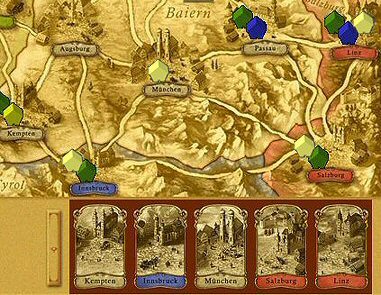
The yellow player has laid out a route of five cities and now wants to score it. Kempten is immediately excluded from the scoring because there is already a yellow route post there. Innsbruck - Munich - Salzburg - Linz are available as candidates. The player now has two options:
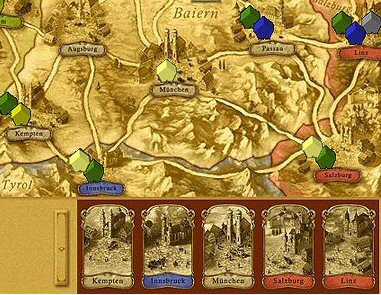
He chooses the first option mentioned above and places one route post per country in one city, i.e. in Innsbruck (Tyrol), Munich (Bavaria) and Salzburg (Salzburg). Linz is also located in Salzburg and can therefore no longer be selected.
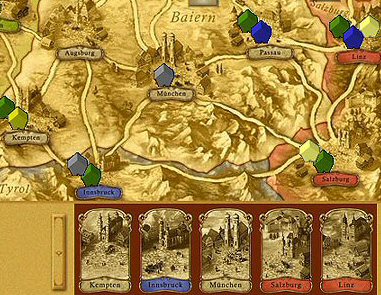
Or he chooses the second option and evaluates all cities of a country. In this case, he takes the two cities in Salzburg (Salzburg and Linz). This means he can now choose neither Innsbruck nor Munich. Alternatively, he could of course have chosen Innsbruck or Munich, but would only have been able to get rid of one route post.
Afterwards, new carriage cards and/or bonus tiles may be awarded and surplus cards may be discarded:
Carriages
Each player can acquire a maximum of five better carriages. Carriages are only ever awarded in ascending order, i.e. you first acquire a three-man carriage, then a four-man, five-man, etc. No level may be skipped, even if this would be possible in terms of route length. You will always receive the next highest carriage if the route length is at least equal to the required number of carriages.
So if a player previously had a four-man carriage, they must now score a route of at least length 5 to gain a five-man carriage. They can also use the Wagner (see above).
There are carriages of sizes 3/4/5/6/7.
Bonus tiles
If you meet certain requirements after scoring, you can use bonus tiles to boost your score. The following applies to all bonus tiles:
There are four types of bonus tiles:
Fully occupied countries





You receive these bonus tiles if you have a route post in each city of the corresponding colored country or the two country combinations. The country tiles are located in the corresponding countries or on the country border.
Track length



If the scored route comprises at least 5, 6, 7 or more cards, you receive the top card of the corresponding pile. If the exact length is no longer available, you receive the top card of the stack for the next shortest route. This also applies to routes longer than 7. A player can acquire several bonus tiles of the same length during the course of the game.
All countries

You receive this bonus tile if you have at least one waypost in all countries. It doesn't matter how many cities are occupied in each country - the main thing is that there is a sentry in one of them.
Fine del gioco

The player who reaches one of the end conditions first receives this bonus tile.
Discard city cards
If you have more than three cards in your hand after scoring, you must discard the excess.
Fine del gioco
The game ends as soon as a player has either used all their track posts or acquired the seven-carriage tile. They receive the end-of-game bonus tile, which counts as one victory point. However, the current round is always played to the end.
Punteggio
At the end of the game, the total score is calculated from the following points:
In the event of a tie, the player with the most victory points wins whoever has the bonus tile at the end of the game or is closest to the owner in turn order.
Opzioni
map 1 South/2 North
With this option, you can switch between the maps of southern and northern Germany. The rules of the original game apply exclusively to the map of southern Germany, while the map of northern Germany can be played using both the standard rules (including the new rules for placing houses and for the bonus tiles) and the "horses" option (see below).
The following special features apply to the Northern Germany map:
horses
The "horses" option can only be played with the North Germany map. The rules of the basic game apply with the following exceptions:
The city cards now have two functions: they can be played as normal city cards as before or you can turn them over and attach the back with the horses to your carriage. To do this, select the desired hand card and then click on your carriage. If you choose the postillion, you can also combine the two actions: i.e. place a city card on the track and place a city card on the carriage.
If you want to score a route, the carriage must have at least as many horses (horseshoes) as the route is long. Please note that the carriage is already pulled by two horses. A maximum of six cards may be attached to the carriage.
After scoring, all city and horse cards are discarded. Here, too, the rule applies that you may only keep a maximum of three cards in your hand after scoring.
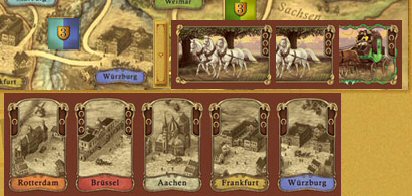
Here, the player has already built a five-card track. He has already attached two cards with three horses each (horseshoes) to his carriage, so that he can even score a route of eight with this configuration (3+3+2 horses).
As soon as a player has built all their houses, the round is played to the end. The game then ends.

